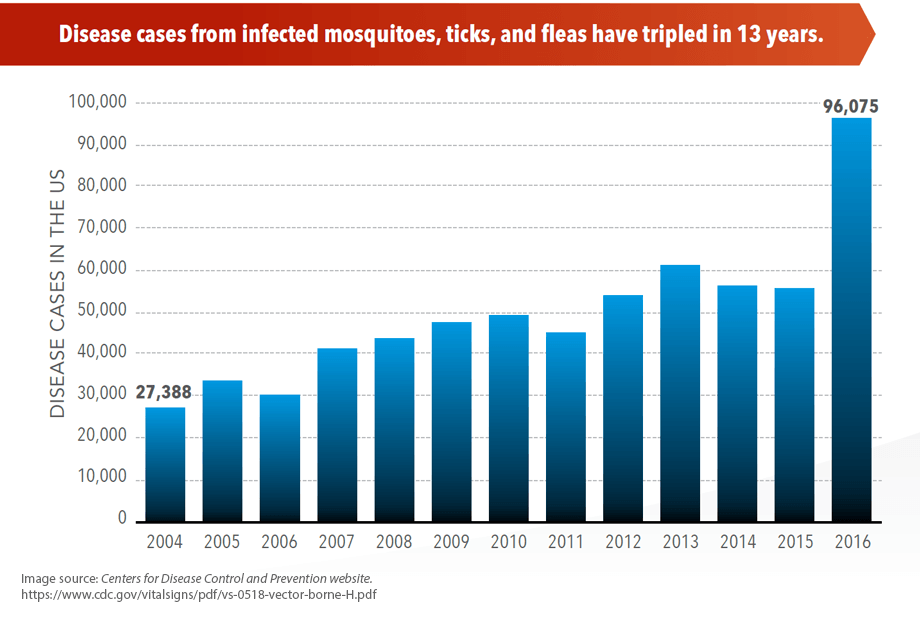“Disease cases from tick, mosquito, and fleas tripled in the US from 2004-2016.” According to a study the CDC published in May, 2018:
Vectorborne diseases are major causes of death and illness worldwide. In the United States, the most common vectorborne pathogens are transmitted by ticks or mosquitoes, including those causing Lyme disease; Rocky Mountain spotted fever; and West Nile, dengue, and Zika virus diseases. . .
A total of 642,602 cases were reported. The number of annual reports of tickborne bacterial and protozoan diseases more than doubled during this period, from >22,000 in 2004 to >48,000 in 2016. Lyme disease accounted for 82% of all tickborne disease reports during 2004–2016. The occurrence of mosquitoborne diseases was marked by virus epidemics.
This summer we must diligently protect ourselves when outdoors. Some species of mosquitos live indoors, meaning we must use protection indoors as well. The EPA suggests citronella oil as effective mosquito and tick repellent. However, they recommend reapplying hourly.
The CDC suggests using permethrin to treat clothes, or buying permethrin treated clothes.
In April I took my first trip to India, for retreat. As a neophyte traveler, I spoke to many colleagues about precautions. The issue of insect repellent arose. I avoid chemicals, so did not want to apply DEET to my skin. Many colleagues had traveled to the third world and provided experiential advice that I will share with you.
Three essential oil products came highly recommended. Keep in mind when using essential oils, you must reapply frequently: every hour or two.
Burt’s Bees insect repellent works well against mosquitos, flies, and no-see-ums for a colleague traveling multiple times in the deep jungle. Another colleague uses Whole Clarity insect repellent with good results in the tropics: Mexico and the Caribbean. I have heard many raves about doTerra Terrashield. All of these use essential oils. You must apply the oil directly to the skin at the venous pulse points: inside wrists, elbows, ankle, behind knees, inguinal region (groin), sides of the neck.
Essential oils don’t seem to work for everyone. Some do well with one product, while someone else finds a different product more effective. So try several options to see what offers you the best protection.
The CDC also recommends permethrin-treated clothing. Permethrin is the synthetic form of a compound found in chrysanthemum blossoms.
The University of Rhode Island TickEncounter Resource Center Permethrin Fact Sheet discusses efficacy:
- It has been used as a clothing treatment to prevent bites from ticks, flies, and mosquitoes since the 1970s, and used by the military since the 1990s.
- It provides a quick tick knock-down effect – both repels and kills.
- A URI study found that people wearing permethrin-treated sneakers and socks were 73.6 times less likely to have a tick bite than those wearing untreated footwear.
You can purchase pretreated clothing and outdoor equipment at sporting goods stores, such as REI, LL Bean, or InsectShield. The pretreated clothing protection seems to last the lifetime of the item. You can also buy permethrin and spray the clothing yourself. The DIY method last for 5-6 washings. InsectShield also offers a service where you can send your own clothes in for professional treatment, lasting up to 70 washings.
The CDC emphasizes spraying shoes and socks for ticks. Another option, if you are going to be out in the woods hiking or working in the yard is wearing a bug suit or gators.
Enjoy your summer and stay safe!



